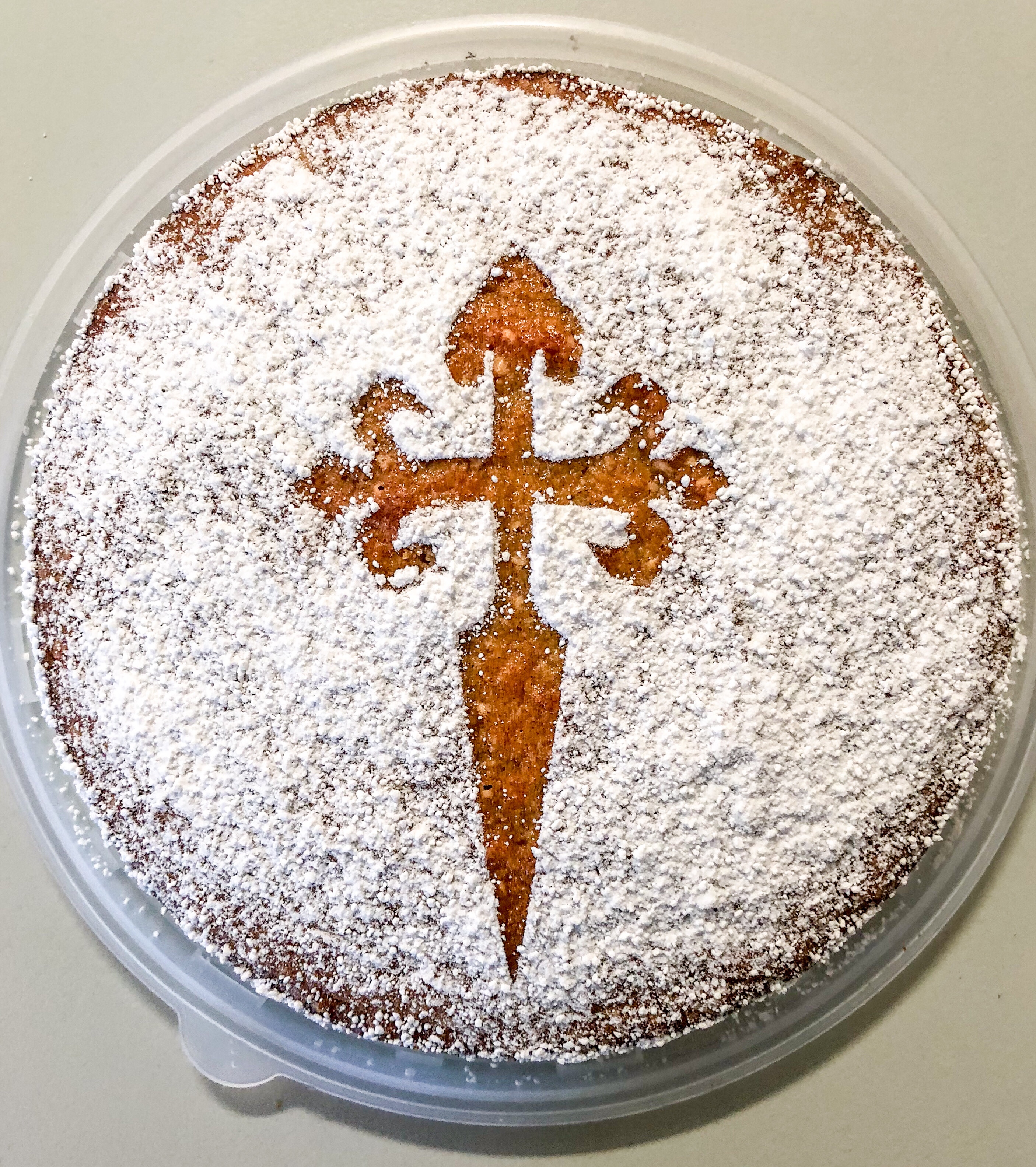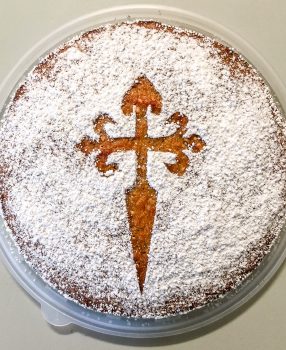Anyone who has walked the ancient pilgrimage route of the Camino de Santiago will have encountered a delicious almond cake with a characteristic cross of the Order of Santiago outlined in icing sugar. This is the Tarta de Santiago originating in the Spanish Autonomous Community of Galicia. I’ve included the recipe at the end of this post 😊

The recipe dates back at least to 1577 when it was documented by Don Pedro de Portocarrerro during his visit to the University of Santiago de Compostela. He was conducting a study of meals provided to the professors during the conferring of degrees ceremony. But its origins possibly go back much further.
At that time it was a nutritious plain almond cake, and the cross decoration was added in 1924 by the founder of Casa Mora – a cake shop in Santiago, and the idea soon spread throughout Galicia.
But I have my suspicions that the Santiago cake might be an adaptation from a Moorish orange and almond cake, these days associated with Morrocco and Tunisia. In the ninth century, most of Spain and Portugal was in the hands of the Moors – moslem invaders from North Africa – so it is likely that there was a considerable amount of cultural exchange between the Moors and the Christians.
This exchange is reflected in the so-called mozarabe architecture notably in Southern Spain, but there are hints throughout, even in Burgos’ French Gothic Cathedral, where the lacework in the spires is reminiscent of Moorish stonework.
The cake itself has a high protein and energy content, but has no dairy fats to spoil, making it an excellent journey cake for pilgrims. It is gluten free, low carb and high energy, so it works well as a low-tech energy bar for hikers.
In medieval times, when up to a quarter of a million pilgrims were on the road each year journey bread or way-bread enabled travellers to sustain themselves between stops with a healthy energy-rich and durable food.
In northern Europe, this was often a honey bread made from barley, wheat or rye. Such foods were the inspiration for JRR Tolkein’s elvish bread that he called Lembas bread – derived from Lammas Bread – traditionally baked from the first flour of the season as part of a harvest festival. According to the Real Bread Campaign, the word Lammas itself is derived from hlafmaesse, the Old English word for ‘loaf mass’.
Regardless of its origins, the cake is now firmly associated with Galicia and with the Camino de Santiago. So much so, that in 2010 it was added to the EU register of Protected Geographical Indications – its recipe has been governed since 2007 by EU regulations. These comprise at a minimum:
“— high-quality almonds, which must account for at least 33 % of the total weight of the mix. These almonds must have a fat content of more than 50 % measured in the untrimmed product.
— refined sugar (sucrose), which must account for at least 33 % of the total weight of the mix,
— eggs, which must account for at least 25 % of the total weight of the mix,
— lemon zest and icing sugar, sweet wine, brandy or grape marc, depending on the recipe used.”
And there are rules for packaging, labelling and display of the official seal of the protected geographical indication.
Of course, following our first Camino I just had to locate the recipe and see if I could replicate the results – and for anyone curious, here is my recipe for the Tarta de Santiago:
Tarta de Santiago
INGREDIENTS
- 250 g almond meal
- 150 g raw sugar
- 1 lemon or orange zest, finely grated
- ½ teaspoon cinnamon
- 5 eggs
- 1/2 teaspoon vanilla essence
- 1 tblspn orange juice, port, brandy, or sweet wine
- 1 tsp icing sugar (not icing mixture) to dust
INSTRUCTIONS
- Preheat the oven to 170°C.
- Line a 20 cm springform tin with baking paper.
- Combine the ground almonds, sugar, zest, juice/wine/brandy (delete as applicable)and cinnamon in a mixing bowl. You can also add a tablespoon of orange juice or substitute orange zest for the lemon. In a separate bowl lightly beat the eggs and vanilla paste until just combined. Pour the beaten eggs into the almond mixture and stir well to form a batter. Pour the batter into the prepared tin and bake the cake for 30-40 minutes, or until golden.
- Allow the cake to cool in the tin before removing. When cooled completely, lay the cross stencil in the centre of the cake and dust liberally with icing sugar. Carefully remove the stencil and serve. [Tip: I attach two small handles to the template using sticky tape for easy removal after dusting]. You can find Santiago cross designs on the web.


Hi Jerry, I’ve just come across your recipe for Tarta Santiago having recently been introduced to your blog. The blog was, as ever, very interesting and as Geoff, my husband, is a good amateur baker I have persuaded him to bake it for me. All I’ve got to do now is to plan my next walking adventure with my daughter and, with appropriate sustenance in hand, boldly go.
Hi Marion – many thanks for your lovely comment – Enjoy the tarta de Santiago! It was my favourite cake on the Camino and now my favourite cake to bake 🙂 Enjoy your walking adventures! And enjoy the time with your daughter — a special time indeed! We are planning our next adventure too 🙂 Yes, boldly go — with journey-cake in hand!
Love Tarta Santiago – discovered it last year while walking the Camino. I’ve got a pretty good recipe, but yours sounds really yummy.
Wonderful! I always enjoy your insights into other worlds and the connections to Lembas are intriguing. I’m so glad you found a recipe for this rather than Cram!
I missed the quantity for vanilla paste. I am not familiar with it
Thanks so much for sharing!
Thanks Beth – the quantity of vanilla paste is around half a teaspoon (varied according to taste) The vanilla wasn’t part of the original recipe, but it works well.